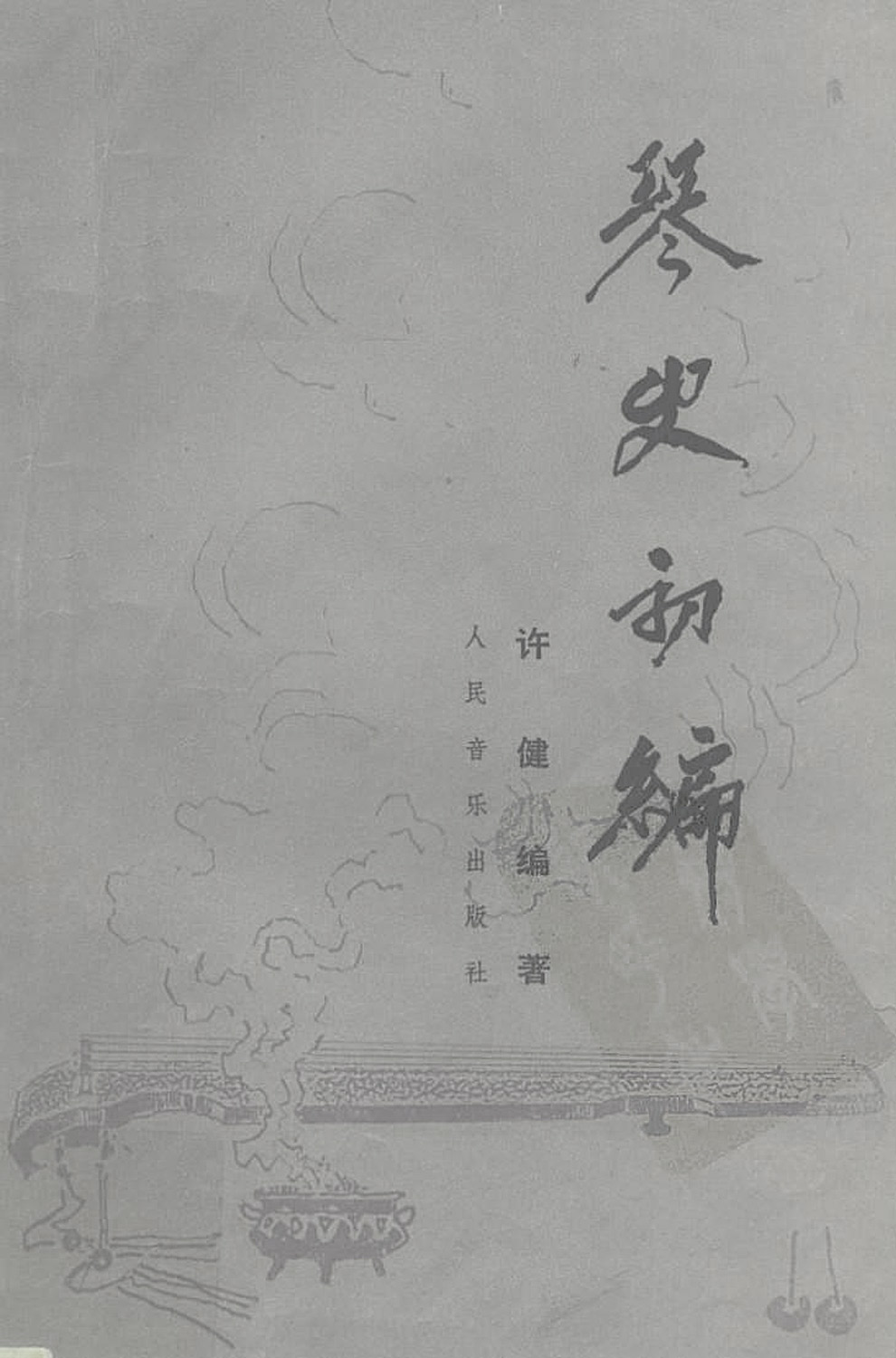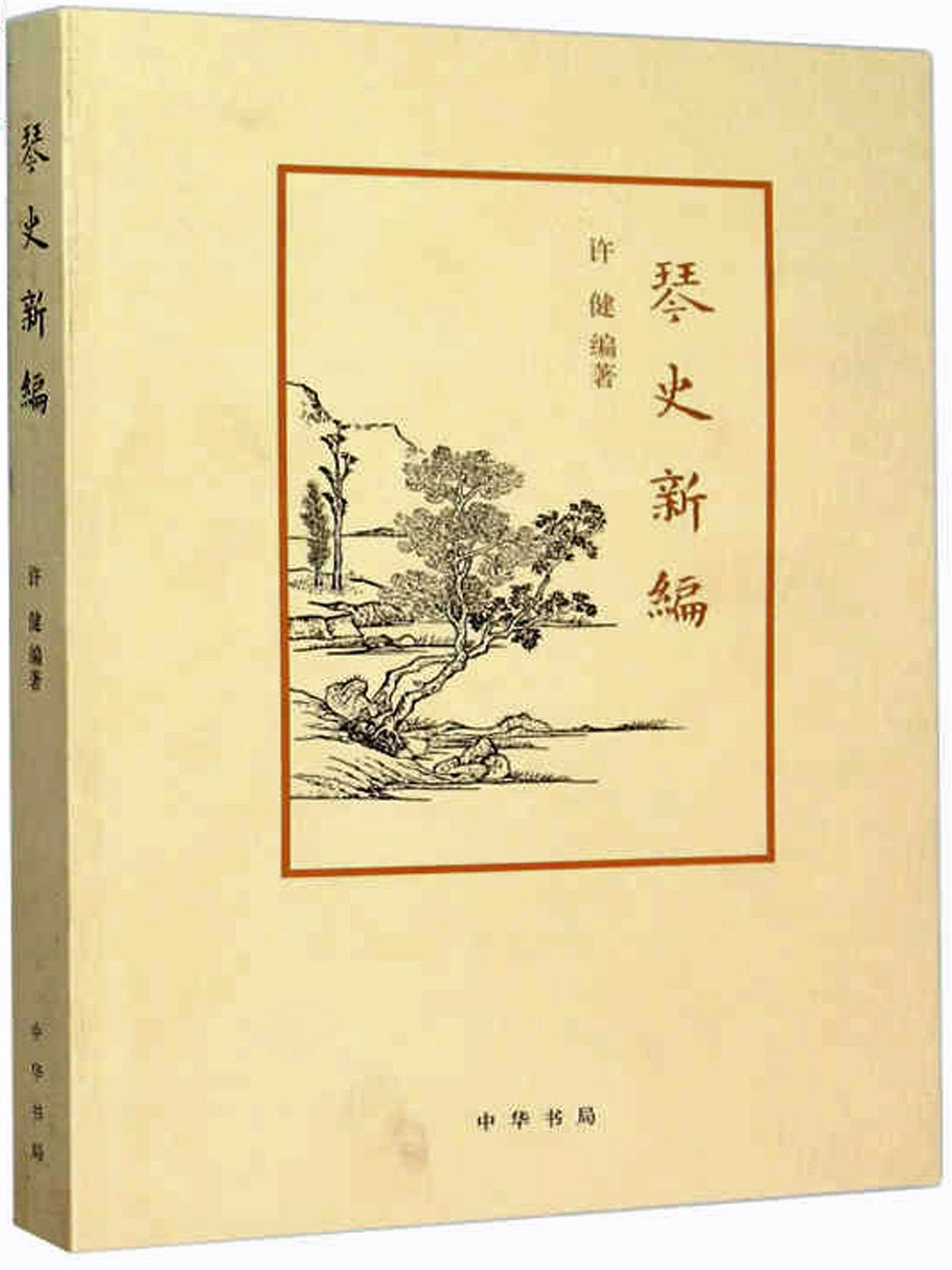|
T of C
Home |
My Work |
Hand- books |
Qin as Object |
Qin in Art |
Poetry / Song |
Hear, Watch |
Play Qin |
Analysis | History |
Ideo- logy |
Miscel- lanea |
More Info |
Personal | email me search me |
| Qin biographies Qin origins Nan Bei Sui Tang Song Yuan Ming 2012 edition | 中文(殘) 首頁 |
|
Introductory History of the Qin
By Xu Jian2 |
琴史初編 1
許健 2 |
| Qin Shi Chubian, 1982 (compare 2012) |
 Translated sections have links, but links preceded by "discusses" are simply to where further information will be.
Translated sections have links, but links preceded by "discusses" are simply to where further information will be.
1. Beginnings to Qin dynasty (pp. 1 - 10; 中文)
Discusses: Zhong Yi, Shi Cao, Shi Kuang, Shi Juan, Bo Ya and Yongmen Zhou.
B. Qin Melodies (pp. 7 - 10)
Discusses:
Zhi Zhao Fei,
Yan Yi Ge and
Yang Chun Bai Xue
2. Former and Latter Han (pp. 11 - 23; 中文)
Discusses: Sima Xiangru, Shi Zhong, Zhao Ding, Long De, Liu Xiang,
Wang Zhengjun, Zhao Feiyan, Huan Tan and Cai Yong.
B. Qin Melodies
Discusses:
Yin Ma Chengcheng Ku (see Cai Yong's
Qin Fu),
Nie Zheng Ci Han Wang Qu (see
Guangling San), and
Bie He Cao (see Bie Gu Cao)
3. Wei and Jin (pp. 24 - 39; 中文)
Discusses: Cai Yan, Du Kui, Ruan Yu, Ruan Xian, Ruan Zhan,
Ruan Ji, Xi Kang, Zuo Si and Liu Kun.
B. Qin Melodies
Discusses:
4. Northern and Southern Dynasties (pp. 40 - 51; 中文)
Zong Bing
Liu Yun and Liu Shilong
Liu Xie
B. Qin melodies
5. Sui and Tang (pp. 52 - 82; 中文)
Heruo Bi
Wang Tong
Wang Ji
Zhao Yeli
Dong Tinglan
Xue Yijian
Chen Kangshi
Chen Zhuo.
B. Qin melodies
C. Qin tablature and Qin making
6. Song and Yuan (pp. 83 - 121; 中文)
- Qin monk teachers and disciples in the Northern Song dynasty
- Literati and Qin Masters
- Zhe(jiang) school of the Southern Song (1127-1280)
- Qin Experts of the Jin and Yuan Dynasties
- Emperors Addicted to the Qin
B. Qin Melodies
I. Introduction to qin melodies, then (with most musical examples omitted):
II.
From Title Lists Looking at Qin Melody Performance Development
III. Diaozi (short songs) and Caonong (instrumental melodies)
C. Qin Essays
Introduction to the essays, then:
- Zhe(jiang) Melodies of the Xumen tradition (pp. 123 -125; 中文)
Xu Hezhong
Huang Xian (1485 - 1561; see also Wugang Qinpu)
Xiao Luan (1487 - 1561; see also Taiyin Buyi and Taiyin Xupu) - Yushan School (pp. 125 - 128; 中文)
Yan Cheng; and Songxianguan Qinpu
Xu Qingshan; and Dahuange Qinpu - Shaoxing Qin School (pp. 128 - 129; 中文)
Yin Ertao; see Huiyan Mizhi
Zhang Dai; also see Huiyan Mizhi - Creators of Qin Songs (pp. 130 - 131; 中文)
(Concerns only the late Ming: see comment.)
Chen Dabin
Chen Shi
Wu Guiyun
Lu Yaohua
Yu Qian - Qin experts who opposed the Qing dynasty (pp. 131 - 132; 中文)
Kuang Lu
Hua Xia
Li Yanshi (or Li Yanxia)
Jin Qiongjie - Craftsmen who played qin (pp. 132 - 133;
中文)
Xu the dye craftsman (徐染匠 Xu ranjiang)
A certain carpenter (某木匠 mou mujiang)
The hat craftsman (補帽匠 bumaojiang) - Skilled qin makers (pp. 133 - 134;
中文)
Zhang Jingxiu 張敬修
Shi Yanzhao 施彥昭
Wu Shi 吳拭
Yan Diaoyu 嚴調御
B. Qin Melodies. Discusses:
- Zhu Quan and the qin melody Qiu Hong (partial translation here) (pp. 134 - 139; 中文)
- Pingsha Luo Yan (pp. 139 - 141)
- Yu Qiao Wenda (pp. 141 - 143)
- Liangxiao Yin (p. 143)
- Shitan Zhang (p. 144)
- Yi Qiao Jin Lü (pp. 144 - 145)
- Boya Diao Ziqi (pp. 145 - 147)
C. Qin essays. Discusses:
Translated in Van Gulik, Lore, pp. 108 - 116
24 such methods; mentioned in VG, Lore, p.107
- Han Jiang
Zhuang Zhenfeng (ca. 1624 - after 1667)
Cheng Xiong
Jiang Xingchou (Shin-Etsu; 1639 - 1696)
Shen Guan (see Qinxue Zhengsheng)
Wang Xuan (Wang Fu; 1692 - 1759)
Wang Shan (1678 - after 1758)
Xu Qi
Wu Hong
Wang Mingchen 汪明辰 (studied from 先機和尚 a student of Wu Hong)
Qin Weihan (1816-ca.1868; see Jiaoan Qinpu)
B. Qing dynasty Qin Melodies (p. 160)
C. Qing dynasty Qin Essays (p. 165)
Five essays
- Daring to take melodies from popular culture: Zhang Jutian
Compiled/wrote Zhang Jutian Qinpu - Zhu Tongjun (i.e., Zhu Fengjie) and his followers
Zhu Tongjun; Zhang He (see Qinxue Rumen); Chen Shiji - Zhang Kongshan and (his disciple) Gu Yucheng of the Chuanpai (Sichuan School 中文)
For Zhang Kongshan see Tianwenge Qinpu - The Wang family of 諸城 Zhucheng (west of Qingdao, Shandong province)
(See the Zhucheng school handbooks such as Qinpu Zhenglü, Tongyin Shan Guan Qinpu and Mei An Qinpu)
Wang Fuchang, Wang Zuozhen, Wang Yumen, Wang Lu, Wang Lubin (elsewhere Wang Binlu) - Huang Mianzhi and qin masters in the capital
Huang Mianzhi (1853-1919; listed under 九嶷 Jiuyi style in the Zha chart but also said to have learned from Shi Kongchen, associated with the Guangling School);
His student Yang Zongji ("Jiuyi Shanren") compiled Qinxue Congshu); others included Jia Kuofeng, Fu Tong, Shi Yinmei and Zhang Chunpu
B. Qin Melodies (pp. 177-81
10. Contemporary (pp. 187 - 195)
B. Qin Melodies
Afterword (p. 196)
1.
Introductory History of the Qin
2.
許健 Xu Jian (1922-2017) (see also
here and
here as well as
this obituary)
Footnotes (Shorthand references are explained on a
separate page)
北京,人民音樂出版社 Beijing, Renmin Yinyue Chuban She, 1982. The links above are mostly to pages that have been translated, mostly by myself but quite a number were done by 金秋雨 Jin Qiuyu (search me for "金秋雨" or "Jin Qiuyu").
(Return)
In 2012 Xu Jian published a new edition of this book, called 琴史新編 Qin Shi Xin Bian (Qin History, New Edition), with further material (see Appendix below).
Appendix
Contents of Qin History New Edition
琴史新編目錄 Qin Shi Xin Bian Mulu (2012)
| Qin Shi Xinbian, 2012 (compare 1982) |

This book is a new edition by Xu Jian based on his 1982 Introductory History of the Qin (above). The outline below of the new edition (standard characters, modified from baike.baidu.com) has links from each chapter going to the corresponding chapter of the earlier edition above, while the chapters and their sections above are romanized and have links to further information. This shows that, while the new edition has the same format, it also has significant additions, in particular:
- It inserts 23 附錄 further commentaries throughout, but particularly for more recent times
- It adds a 評 commentary at the end of each chapter
- It adds an 11th chapter with 余論 extra essays
The 評 chapter commentaries and 余論 extra essays are indented below.
前言
附錄一 千載頌清風 : 許由
第二節 琴曲 《雉朝飛》/《扊扅歌》/《陽春》《白雪》
附錄二 洋洋盈耳話《關雎》
附錄三 穆穆皇皇雍容《大雅》
附錄四 曲高和寡話《陽春》
一評:「琴瑟友之」說明了什麼?
第二節 琴曲 《飲馬長城窟》/《聶政刺韓王曲》/《別鶴操》
附錄五 弦歌與琴歌
二評:《文王操》如何表現?
第二節 琴曲 《廣陵散》/《酒狂》/《梅花三弄》
附錄六 衝冠怒亦深 : 《廣陵散》辨,兼答《投劍功無補》文
附錄七 琴曲中的《春之歌》 : 《修禊吟》
附錄八 《梅花》尋源
三評:目送歸鴻,手揮五弦
第二節 琴曲 《碣石調·幽蘭》/《烏夜啼》/《懊歌》
四評:撫琴弄操響眾山
第二節 琴曲 《大胡笳》和《小胡笳》/《昭君怨》/《風雷引》/《頤真》/《離騷》/《陽關三疊》/《漁歌調》
附錄九 最憶《陽關》唱珍珠一串歌
第三節 記譜和斫琴 一 譜式的革新 二 造琴工藝的發展
第四節 唐詩中的琴
附錄十 為我一揮手如聽萬壑松 : 李白的綠綺情結
五評:字簡義盡,文約音該
一 北宋的琴僧師徒 朱文濟/夷中/知白/義海/則全/照曠
二 文人與琴家 歐陽修/沈遵/崔閒/蘇軾/葉夢得/吳良輔
三 南宋的浙派 張岩/郭楚望/劉志方/楊瓚/徐天民/毛敏仲/汪元量/宋尹文/徐理/俞琰
四 金元琴家 苗秀實/耶律楚材
五 嗜琴的皇帝 趙匡義/趙佶/完顏璟
第二節 琴曲
一 琴曲介紹 《楚歌》/《胡笳十八拍》/《瀟湘水雲》/《漁歌》/《醉翁吟》/《澤畔吟》/《古怨》/《黃鶯吟》
二 從曲目看琴曲的演變
三 調子和操弄
附錄十一 姜夔及其琴曲《古怨》
第三節 琴論
一 朱長文《琴史》
二 袁桷《琴述》
三 崔遵度《琴箋》
四 劉籍《琴議》
五 陳敏子《琴律發微》
六 則全和尚《節奏、指法》
七 成玉《論琴》
八 趙希曠論彈琴
九 碧落子《斫琴法》及其他
附錄十二 天上曲調人間音 : 六一琴論初探
六評:清厲而靜,和潤而遠
一 朱權、蔣克謙
二 浙操徐門 徐和仲/黃獻/蕭鸞
三 虞山派 嚴澄/徐青山
四 紹興琴派 尹爾韜/張岱
五 琴歌作者 陳大斌/陳詩/吳歸雲/陸堯化/虞謙
六 抗清琴人 鄺露/華夏/李延昰/金瓊階
七 工匠琴人 徐染匠/某木匠/補帽匠
八 斫琴能手 張敬修/施彥昭/吳拭/嚴調御
第二節 琴曲 《秋鴻》/《平沙落雁》/《漁樵問答》/《良宵引》/《釋談章》/《圯橋進履》/《伯牙吊子期》
附錄十三 琴史上的第一譜集 : 《神奇秘譜》
第三節 琴論
一 冷謙《琴聲十六法》
二 徐青山《溪山琴況》
附錄十四 評《溪山琴況》
附錄十五 虞山派的「清微淡遠」
七評:聲既異門,學亦隨判
一 韓畕及琴歌作者
韓畕/莊臻鳳/程雄/蔣興儔/沈琯/汪烜/王善
二 廣陵派
徐常遇/徐祺/吳灴/汪明辰/秦維瀚
三 金陶及其門弟子
金陶/雲志高/韓桂/戴長庚/蔣文勳
附錄十六 琴派的形成與演變
第二節 琴曲 《水仙操》/《鷗鷺忘機》/《龍翔操》/《梧葉舞秋風》
第三節 琴論
一 莊臻鳳的《琴學心聲·凡例》
二 戴源的《鼓琴八則》
三 王坦、曹庭棟的琴律研究
四 陳幼慈的琴論
五 蔣文勳的《琴學粹言》
八評:操弄調引,功能各異
一 敢於「從俗」的張鞠田
二 祝桐君及其後繼者 祝桐君/張鶴/陳世驥
三 川派張孔山及顧氏家族
四 諸城王氏 王溥長/王作禎/王雩門/王露/王賓魯 五 黃勉之及京師琴家 黃勉之/楊宗稷/賈闊峰/溥侗/史蔭美/張春圃
第二節 琴曲 《流水》/《醉漁唱晚》/《長門怨》/《關山月》/《秋風詞》
第三節 琴論
一 祝桐君的《與古齋琴譜》
二 陳世驥的《制曲要篇》
三 楊宗稷的《琴話》、《琴粹》
九評:漸引入調,稍緊成章
附錄十七 為重振琴壇畢生操勞 : 古琴家查阜西
附錄十八 弦上萬古意清心向流水 : 古琴家管平湖
第二節 琴曲 《憶故人》/《泣顏回》
第三節 琴論
第四節 新中國的古琴
附錄十九 古樸典雅獨樹一幟 : 談查老的琴歌
附錄二十 萬里訪古琴
附錄二十一 訪吳、越、閩琴友記
附錄二十二 悠悠琴韻四十年 : 論中國藝術研究院音樂研究所
附錄二十三 介紹北京古琴研究會
十評:保護遺產,任重道遠
第十一章 余論
二 「琴德最優」四解
三 古曲尋聲話打譜
四 關於譯譜
代後記 古琴,路在何方?
Return to the Guqin ToC